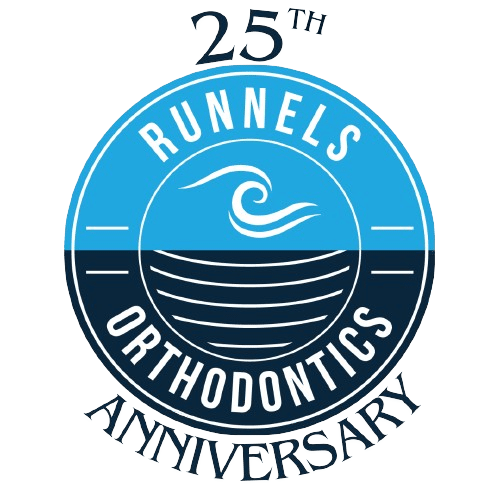Orthodontics is a process that takes time rather than delivering instant results. Each phase is designed to move you closer to achieving a healthier mouth and a more aligned smile. Because every individual’s dental structure and corrective needs are unique, the path to achieving these goals varies from one person to another.
At Runnels Orthodontics in Destin, FL, we are prepared to guide you through the various steps involved in orthodontic care. From initial assessments to detailed adjustments, we’ll explore what you might expect on your journey toward resolving dental misalignments and bite issues. This will include a look at some common treatments and technologies that can help correct your dental concerns, aiming for a straighter and brighter smile.
What Can Orthodontics Treat?
- Misaligned Teeth: Often visible as crooked or overcrowded teeth, misalignment can be corrected through various orthodontic interventions, enhancing both oral function and aesthetics. Misaligned teeth not only affect your smile but also your ability to chew and clean your teeth effectively. Orthodontics offers solutions such as braces and clear aligners to systematically adjust teeth into better positions.
- Overbite/Underbite: Bite irregularities involve the upper teeth overlapping the lower teeth (overbite) or the lower teeth protruding beyond the upper teeth (underbite), potentially leading to jaw discomfort and wear on teeth. Bite correction is important for preventing further oral health complications.
- Spacing Issues: Gaps between teeth may be a cosmetic concern for some, while for others, they pose a risk to overall dental health by trapping food and causing gum disease. Orthodontic treatments can close these gaps, leading to a healthier mouth and a more uniform appearance of your teeth.
- Jaw Misalignment: Misalignments of the jaw can cause uneven wear on the teeth, chronic pain, and difficulties with speaking and eating. Addressing jaw misalignment often involves more comprehensive orthodontic strategies, which can include braces or other methods to realign the jaw structure properly.
- Broken Equipment: An emergency orthodontist can care for any broken equipment you may have, such as broken wires, brackets, retainers, and more.
Pre-Treatment Preparations
S.M.A.R.T. Analysis
For younger patients, the S.M.A.R.T. Analysis can be used for both preventative and corrective orthodontics. This evaluation includes:
- S-mile checks for asymmetry and malocclusions
- M-axillary constriction assessments to ensure the palate is wide enough for healthy breathing
- A-irway, adenoids, and tonsil examinations using 3D digital X-rays and CBCT for potential obstructions
- R-oot angulation analysis for proper lower molar positioning
- T-reatment planning using advanced digital tools to customize treatment strategies
This approach not only helps us craft precise treatment plans but also involves providing patients with a flash drive of all relevant records, enabling seamless coordination with pediatricians or ENT specialists.
Oral Health Optimization
Before initiating any orthodontic treatment, it’s important to achieve a state of optimal oral health. Issues like cavities, gum disease, and plaque build-up need to be addressed. The difference between an orthodontist vs. dentist lies in their focus. While both work toward improving oral health, orthodontists specialize in correcting irregularities and aligning the teeth and jaws. We can coordinate with your dentist on any oral health concerns that need to be addressed before treatment.
Preparatory Jaw Adjustments
Adjusting the jaw in preparation for orthodontic devices helps prevent complications during the actual teeth straightening phase. Techniques used in this phase can include using expanders to adjust the width of the jaw or other appliances that gradually guide the jaw into a more favorable position for subsequent bite correction. These adjustments are different depending on individual anatomical needs and can enhance the effectiveness of the main treatment phase.
Choosing the Right Orthodontic Treatments
Types of Braces
Braces are devices that we use to straighten your teeth while also making your smile healthier. They correct underbites, overbites, open bites, deep bites, crooked teeth, and various other flaws of the teeth and jaw. Here are the main types:
- Metal Braces: The most traditional form of braces, these are made from high-strength stainless steel and are the most visible type. They offer a reliable, cost-effective solution for complex dental alignments.
- Ceramic Braces: Made from composite materials, these braces are less noticeable than metal braces as they blend in with the teeth’s natural color. They are popular among older teenagers and adult patients who desire a less conspicuous appearance.
- Lingual Braces: These are attached to the back of the teeth, hiding them from view. Lingual braces are customized to match the shape of your teeth, making them nearly invisible when you smile.
- Self-Ligating Braces: Using a slide mechanism that holds the wire, these braces reduce the amount of pressure exerted on the teeth and require fewer adjustments. They come in both metal and ceramic options.
Clear Aligners
Clear aligners, including Invisalign, are becoming a favored option for those who don’t want traditional braces. These aligners are custom-made from clear, plastic material that subtly realigns your teeth. The virtually invisible Invisalign trays can be taken out for meals and dental hygiene, providing a convenient and low-profile solution for those looking to enhance their smile discreetly. Typically, each set of aligners is worn for a two-week period before moving on to the next set in the series.
PROPEL® for Faster Treatment Times
PROPEL® orthodontics provides an advanced option for patients looking to speed up their treatment process and is especially useful for those dealing with crowded teeth. This technology works by stimulating bone remodeling, allowing the teeth to move into their desired positions more quickly and efficiently than with traditional methods alone. The treatment is non-invasive and can be used in conjunction with any type of orthodontic appliance, whether you’re using braces or clear aligners.
The Braces Journey
Installation Day
This braces installation process typically takes one to two hours, during which the orthodontist attaches the brackets to your teeth, connects them with a wire, and secures everything with elastic bands. It’s normal to experience some discomfort and soreness initially as your teeth start to adjust to the braces and your gums adjust to the brackets, but this will diminish over the following days.
Living With Braces
As you adjust to living with braces, you will need to avoid certain foods that can damage the braces, such as hard candies and sticky snacks, and maintain a rigorous oral hygiene routine to keep your teeth and gums healthy. While it may take a little time to get used to the new sensations, most patients adapt quickly and are able to participate in all their usual activities with minimal disruption.
Regular Adjustments
Regular adjustments are a necessary part of the process when wearing braces. These appointments, typically scheduled every four to six weeks, involve tightening the braces to gradually move your teeth into the desired position.
Aligners, Step-By-Step
Getting Started With Aligners
First, we will assess your dental structure using digital scans or molds. This information is then used to create a series of clear, removable aligners that are designed to shift your teeth gradually over time.
Daily Life With Aligners
Integrating Invisalign aligners into your daily routine is straightforward. These aligners should be worn for 20 to 22 hours per day but can be removed when eating, brushing, or flossing. This flexibility allows for a less intrusive impact on your everyday life while still progressing toward straighter teeth.
Tracking Your Progress
Throughout your aligner treatment, you will have regular check-ups to monitor your progress. These visits ensure that your teeth are moving according to plan and allow for any necessary adjustments to your orthodontic treatment. With each new aligner, you’ll be able to see a gradual transformation toward your desired smile.
Enhancing Aesthetics Beyond Straightening
Teeth Whitening
After completing an orthodontic treatment, teeth whitening is a popular option for enhancing the brightness of your smile. An orthodontist can provide professional whitening services that are more effective and longer-lasting than over-the-counter products. This treatment helps to remove stains and discoloration that may have accumulated during the braces or aligner process, giving you a noticeably whiter smile.
Laser Gum Contouring
Laser gum contouring is another aesthetic process that can improve the appearance of your smile by reshaping the gum line. This technique is used to correct gums that are too low or uneven, which can make teeth look irregular in size or shape. With the precision of laser technology, the process is quick, with minimal discomfort and recovery time, allowing for an enhanced smile that complements your newly straightened teeth.
Discover What the Orthodontic Process Will Look Like for You
At Runnels Orthodontics, we believe effective orthodontic care extends beyond just straightening teeth; it enhances your overall dental health and aesthetics. Located in Destin, FL, we offer a range of treatments from traditional braces to laser gum contouring. Each treatment is carefully planned to give you the best possible results. To learn more about how we can help you or to start your orthodontic treatment, please contact us through our online form or call us at (850) 269-0333.



